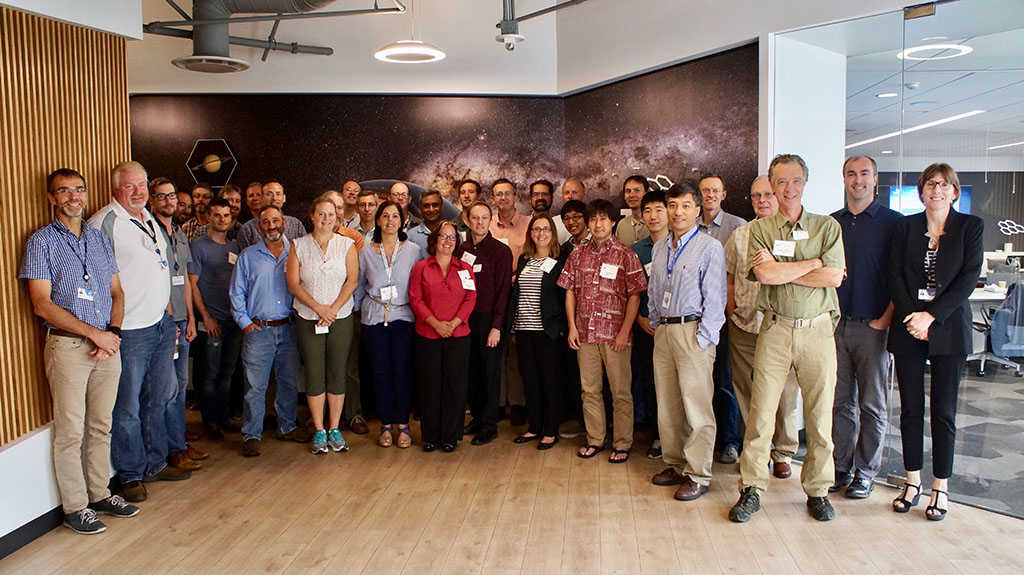
TMT team meeting for IRIS preliminary design review in Pasadena, CA.

Following a successful second IRIS Preliminary Design Phase Review (PDR-2) at the TMT Project Office in Pasadena, IRIS is proceeding into its Final Design phase. The focus of the second review, held in September, involved an assessment of the IRIS software (including its data reduction system) and electrical design (including its detectors) as well as programmatic aspects spanning project cost and overall schedule.
IRIS is a first light instrument designed to operate in the near-infrared (0.84-2.4 μm). It will enable the broad study of astronomical objects by providing data sets that are exquisite in their detail. It will achieve an angular resolution 10 times better than images from the Hubble Space Telescope. As one of the highest angular resolution near-infrared instruments in the world, it will help usher in a new era of astronomical study. The features of the design will enable a vast range of science goals covering numerous astrophysical domains including: solar system science, extrasolar planet studies, star formation processes, the physics super-massive black-holes and the composition and formation of galaxies, from our local neighborhood to high-redshift galaxies.
Review participants included members of the IRIS team, external subject matter experts and key stakeholders. The review panel was chaired by Richard “Ric” Davies, senior scientist at Max-Planck Institute and the principal investigator of the Multi-AO Imaging Camera for Deep Observations (MICADO), one first light instrument for the E-ELT.
In its initial feedback, the review board congratulated and acknowledged the IRIS team on the quality of the presentations and documentation delivered, recognizing the excellent work undertaken by the instrument team to complete the preliminary design phase.
The review featured a thorough assessment of the readiness of the IRIS software design as well as the system’s electrical plan and a revisiting of its operational concepts. Additionally, the team presented its first quality assurance and safety plans. Lastly, PDR-2 also saw the team generate a cost proposal as well as produce its final design phase schedule.
During the latter part of the preliminary design phase, the IRIS science team greatly expanded upon the instrument’s operational concepts, specifically addressing the steps and system interactions involved in preparing for and performing end-to-end observations. To this end, a thorough subset of the envisioned IRIS science cases walked through the anticipated software sequences.
When delivered, IRIS will operate from 0.84 µm to 2.4 µm and offer diffraction-limited imaging and integral-field spectroscopy at wavelengths greater than 1 µm. The design will feature an Imager with a field-of-view of 34”x34” arcsec which relays light into the Integral Field Spectrograph (IFS).
The IFS hosts two slicing techniques to sample the delivered field, each of these provides two plate scale options for a total of four modes. Of these, the lenslet channel will handle the finest plate scales; whereas, the slicer channel will provide coverage for the coarser ones. The IFS will support moderate spectral resolutions of R = 4,000.
IRIS is being designed to take true advantage of all the gains afforded by a 30m class telescope. In its highest spatial sampling, the IFS will yield upwards of 14,000 individual simultaneous spectra. As one of TMT’s first-light instruments, IRIS needs to be versatile, and to this end, the observing modes are enriched by the instrument’s complement of 60 filters and 14 gratings.
The IRIS collaborating institutions include The California Institute of Technology (CIT); The Nanjing Institute of Astronomical Optics and Technology (NIAOT); The National Astronomical Observatory of Japan (NAOJ); The National Research Council (NRC) of Canada Herzberg Astronomy & Astrophysics; The University of California at Los Angeles (UCLA); The University of California at San Diego (UCSD) and The University of California at Santa Cruz (UCSC).
TMT to work with Coherent Inc. to polish primary mirror
Thirty Meter Telescope Narrow Field InfraRed Adaptive Optics System Real-Time Controller Proceeds to Fabrication Phase